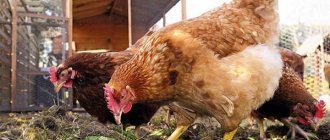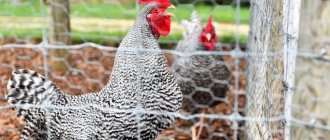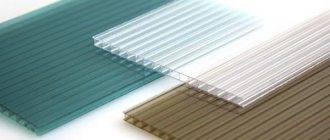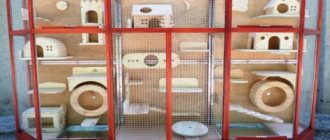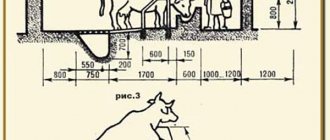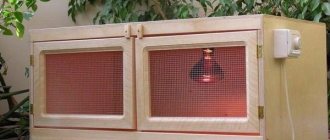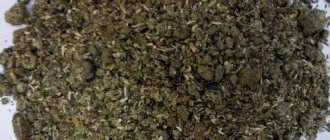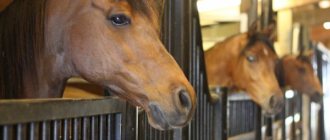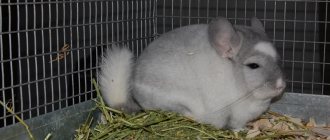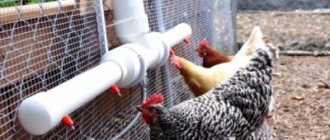Insulating the roof of a chicken coop
When planning a construction, it is recommended to think about the attic and make a structure with a reliable black ceiling.
Subsequently, bedding and feed material can be stored there. In relation to the finished structure, almost the same materials are used (to insulate the roof, additional waterproofing and vapor barrier are used), only the fastening methods change:
- Vapor barrier (vapor barrier films, membranes) is the protection of insulation from moisture that is produced inside the building.
- Waterproofing (roofing felt) serves the same purposes, but is laid outside to protect the insulation from precipitation and condensation formed due to temperature changes.
Step-by-step instructions for insulating a chicken coop
Based on cost, the most convenient type of insulation is polystyrene foam and mineral wool. Before starting insulation, the following tools are required:
- electric drill;
- roulette;
- screwdriver;
- level;
- assembly knife for cutting foam plastic;
- construction stapler;
- hacksaw.
Next, the material is calculated for the entire room. List of materials:
- timber for making a frame (4/4cm);
- sheets of polystyrene foam or polystyrene foam;
- self-tapping screws (for installation in wooden walls), dowels (for hard surfaces);
- mineral or basalt wool;
- vapor barrier film;
- any available panel material (plasterboard, plywood, reinforcing mesh).
The walls are insulated first. The procedure is as follows:
- Along the entire surface of the walls, timber is vertically reinforced at a distance of 60 cm (the width of the insulation). To do this, a beam of the required length is mounted with fasteners (screws, dowels) to the wall, thereby creating a frame for laying insulating material.
- The vapor barrier is fixed with the rough side to the wall. The film is secured with double-sided tape or a construction stapler.
- The next thing to install is insulation. This can be a sheet of foam plastic, mineral wool, or both, depending on the thickness of the walls and climatic conditions. The material is installed on top of the film and tightly joined to the beam. The foam is fastened using umbrella dowels (large diameter cap).
- The final stage is to cover the foam sheet with panels or attach a reinforced mesh. Next, the walls are plastered with cement mortar.
To insulate the roof from the inside, use the same sequence of actions as for the walls. Before the cold weather begins, it is necessary to check the condition of the roof to prevent it from leaking. After the work has been done to insulate the room, the outside walls can be insulated in the same way, but plastered fairly well.
Insulation quality control
It is impossible to visually assess the quality of insulation, because possible imperfections are located inside. Usually for these purposes they resort to a thermal imager, but in the case of a chicken coop this is not advisable. Therefore, quality control is carried out at the stages of material selection and proper installation. Possible errors may lead to the following:
- if the material is chosen incorrectly, cracks appear due to shrinkage;
- If the installation rules are not followed, the vapor barrier seal is damaged, and the lack of ventilation leads to the walls getting wet and freezing.
To be sure of the quality of the purchased material, you need to pay attention to the following points:
- proven, well-known brand of the manufacturer;
- selection of material with suitable characteristics;
- product integrity.
High-quality installation of insulation will guarantee their long-lasting service and preservation of heat in the room throughout the winter.
What symptoms indicate that a chicken cannot lay an egg? More details about this, as well as what to do in this case, are written here.
How to properly raise Linda geese at home? We talked about this in our article.
Cost of insulation
Depending on the size and manufacturer, the price of packaging varies:
- Foam plastic - from 2000-2500 rub.
- Mineral wool from 400-1000 rub.
- Basalt wool from 400-1200 rub.
- Foil penofol - from 300-1700 rub.
- Waterproofing – from 250–400 rub.
- Penoplex - from 100-400 rub.
- Vapor barrier - from 200-2000 rub.
Insulating a chicken coop is a necessary measure for wintering chickens, which guarantees the preservation of livestock and egg production for the entire period. Properly organized insulation allows you to create optimal conditions for birds at different times of the year.
Heating system installation
Most modern poultry farmers prefer electric heaters as the safest and most affordable. You can install them yourself without any special skills. They can heat a room of any size.
Infrared lamp
Infrared lamps (IR lamps) are highly efficient, converting energy into heat. They do not pollute the air in the chicken coop; after switching on, they quickly warm up the area they are aimed at.
The disadvantages of lamps include their high cost and short operating period.
For additional heating of a thoroughly insulated chicken coop with an area of 30 square meters. m and a ceiling height of 200–240 cm, it is enough to install 2 IR lamps, each with a power of 250 W. Lamps are suspended from the ceiling, placing them in those areas of the house where maximum heat is required (for example, above nests, perches or a cage with chickens).
IR lamps should be equipped with a thermostat or dimmer (power regulator) in order to avoid overheating of the room.
Important! When installing an IR lamp, you must remember that it itself gets very hot. It is hung from the wooden ceiling not close to it, but at a distance of 30–50 cm. Or the attachment point is protected with asbestos plate. It is better to take ceramic lamp sockets.
Heater
An IR heater is mounted like an IR lamp (Cozy Warmth, Good Warmth). Its heating area is larger than that of a lamp. It is more reliably protected from overheating. Only ceiling models should be installed in the poultry house so that chickens do not have the opportunity to come into contact with the unit. The cost of an IR heater starts from 2700 rubles.
A popular way to heat a chicken coop is to install a household fan heater or heat gun inside. Not the most economical option, spending up to 1 kW of electricity per hour, but suitable for quickly warming up a room. The fan built into the heater quickly moves air around the room, mixing cold and warm layers. The fan heater has the ability to dry the air.
The unit is installed on the floor or attached to the wall so as to prevent birds from accessing the heater. It is necessary to regularly clean it from dust and feathers, which often accumulate inside the unit.
Calculation of chicken coop parameters
You can very easily calculate the size of the chicken coop using a simple formula: one square meter for four chickens. In addition, you need to think about the foundation for the bird’s future home.
The most important thing for the foundation of a chicken coop is strength. As a rule, the foundation is made of ordinary concrete. There are several reasons for this:
- Preventing boards from rotting. If they are isolated from the destructive effects of wet soil, then the building itself will be much stronger and more durable.
- Preventing Undermining. It's no secret that foxes and other wild animals, and often domestic dogs, are not averse to eating chicken. Once they hit the concrete base, they won't be able to dig a hole into the coop and cause you any damage.
If you don't want to make a concrete foundation, then just carefully line the entire bottom of the coop with iron sheets.
How to make a columnar foundation for a chicken coop: step-by-step instructions
The most common choice is a columnar foundation: it does not require much time and effort, while guaranteeing the reliability and stability of the building. Let's figure out how to make such a foundation yourself:
- start with markings. To do this, take a rope and several thin long pegs or metal rods;
- Next, you need to place pegs in the corners of the future structure and tighten the rope. Carefully ensure that the markings are even. The rope should be taut, but at the same time spread along the top layer of the earth;
- inside the marked area, dig a 15-20 cm hole - you need to remove the top layer of soil;
- dig holes for the posts. Their depth should be approximately 60-70 cm, and their width should correspond to the parameters of two bricks, that is, approximately 50-55 cm. The distance between the pits should be maintained at 1 m. The cabinets must be installed along the entire perimeter of the future chicken coop;
- After finishing digging holes, pull another rope over the rods. It should be at a height of 20-25 cm above the ground. To ensure that the structure is smooth and neat, use a level;
The optimal foundation for a chicken coop is a columnar foundation.
- It is necessary to pour a small layer of sand at the bottom of each hole. The thickness of this layer should be 5-7 cm;
- then fill in the same layer of gravel - both layers serve as a cushion for the future foundation;
- Place two bricks at the bottom of the hole. Next, put a cement solution there in a ratio of 1:3;
- lay two more bricks across. Repeat the steps until the height of the pedestal reaches the level of the top rope;
- if the height of the column is insufficient, level it with cement;
- To protect the foundation from the destructive effects of moisture, its base part should be covered with gravel.
Insulating the chicken coop
Our conditions are such that if you don’t take care of the question of how to properly insulate the chicken coop for the coming winter, the bird will simply die from hypothermia. How to do this?
First of all, during construction, a vestibule must be built in front of the entrance to the chicken coop. This will stop the flow of icy air directly into the room. Once past the vestibule, he will have time to warm up at least a little.
To retain more heat in the chicken coop, you need to make a vestibule. Click to enlarge.
They are good because they can be regularly replaced with new ones, which means the chicken coop will always be clean. It is customary to line the inside of the roof and walls with felt.
During particularly frosty times of the year, care should be taken to connect heating appliances. They can be different - both incandescent lamps and air heaters. The most important thing is that the heating devices cannot be reached by the chickens.
If desired, you can find special films or heating panels made of metal on the market or in a store. They will release heat into the room using infrared radiation.
This method of heating is convenient and economical, since with its help your birds will be able to survive even the most severe cold without any losses, while the energy consumption will not increase, which means it will not hit your pocket.
It is worth approaching this matter with the utmost care, because it is the work you do that will determine how the birds will feel and how well they will lay eggs.
Some tips
Following our advice, your chicken coop will be a reliable home for birds. Click to enlarge.
So, in the chicken coop it is necessary to equip a convenient place where the chicken can safely lay eggs. To do this, you need to install a box filled with sawdust in a secluded corner.
Also, the bird's home requires constant cleaning, so during construction it is best to immediately take this circumstance into account and make the floor slightly inclined towards the door.
Fences for bird walks should be dug into the ground. This is done for greater reliability and to ensure that predators cannot get to the chickens.
You should not purchase a large mesh barrier mesh, since in this case the chickens may escape from the enclosure.
We looked at how to build and insulate a chicken coop. As you can see, everyone can do this.
Types of heating
There are two types of chicken coop insulation in winter: natural and artificial. Both options have a right to exist and have their strengths and weaknesses. Having examined in detail the essence of each type of heating for a chicken coop, the chicken owner will decide which one to give preference to.
Natural
This option is based on carefully insulating the room where the bird is kept for the winter. No heating devices are used. An acceptable temperature in the chicken coop is achieved by eliminating the loss of heat generated by the birds themselves through the walls, floor, windows, ceiling and doors.
They resort to the following insulation measures:
- the walls are made double, with insulation inside;
- second frames are inserted into the windows or covered with film;
- the doors are adjusted to the frame so as to remove all the cracks, the doorway is covered with a blanket or any suitable material;
- the ceiling is sheathed with insulation from the inside or a layer of expanded clay and earth is scattered in the attic;
- when snow falls, it is shoveled up to the barn, insulating the walls from the outside.
The droppings in such a chicken coop are not cleaned all winter; they serve as an additional source of heat. Fresh bedding (sawdust, straw, hay, peat) is added throughout the winter.
This method of heating a chicken coop is chosen in regions with relatively mild winters, where the temperature does not drop below -15–18 degrees. Summer residents who are forced to leave their livestock unattended for several days also resort to it. The use of heating systems in this case is dangerous.
Artificial
If the air temperature in winter drops below 20 degrees, simple insulation is no longer enough. Additional heat sources in the poultry house are:
- wood and coal stoves;
- electric and infrared heaters;
- gas boilers;
- water heating.
The last two options for heating a chicken coop are rarely used in private farmsteads due to the high cost of the equipment and the complexity of installation. Gas and water heating is relevant for large farms, where the profit from the sale of products more than pays for expensive heating.
Installation of stoves of various modifications (potbelly stove, bulleryan, brick) requires certain skills. Operating the stove requires skill and the constant presence of people on the farm; leaving such a heater unattended is dangerous due to the risk of fire or smoke in the room. This option is acceptable if you need to heat the chicken coop without electricity.
The advantage of installing a stove for heating a chicken coop is that the fuel is cheap. The stoves are heated with wood, special sawdust pellets, coal, and lumber waste.
Electric and infrared heaters and lamps are the safest heaters for livestock buildings. By using a fuse that cuts off the current in the event of a short circuit, the likelihood of a fire is reduced to almost 0.
The disadvantages of these heating systems include the need for an uninterrupted supply of expensive electricity.
Best answers
Galina M:
There is no need for a refrigerator if you can’t insulate the entire shed, insulate at least part of it. In villages, chickens winter normally, but only insulated sheds and I agree you can buy an infrared lamp (special for farm animals).
keep it at home
Vladimir:
Anyway, it will be warmer in the refrigerator
Alena Bykova:
Try insulating the shed
Alex U:
can the shed be insulated? lay down straws... cover the walls with something suitable...
Ali Baba:
It’s better if it’s new and already cut up - so that the pieces don’t freeze and each leg is in a separate bag)))))))
rrr:
in a normal barn chickens never freeze
Kotyara:
Insulate the shed with polystyrene foam and screw in a blue lamp... they will be warmer))))))))
Andrey ▒▒▒▒▒▒▒:
If there is no heating, then insulation is useless. Where does the heat come from? 4 frozen chickens will not heat the room. Either provide some heat, or bring chickens into the house.
Sergey Igorevich:
Insulate the barn and put up perches for the chickens; it’s cold on the ground, they need something to sit on...
Olga:
weirdos
Yuri:
Buy them a rooster, it will quickly warm them up)))
Lisa Halanay:
Instead of laying straws in the barn, you should throw a haystack there - the chickens will not freeze in the hay. And why a refrigerator? Make a small pen in your house and let them live until spring. In the warmth and light, even artificial light, chickens lay eggs well in winter.
Doberman Crystal:
I now have three elite chickens imported from China sitting in my apartment in a large exhibition dog cage. If the bird is cold, be sure to bring it somewhere warm; no amount of straw or hay will help. For a couple of months you will live with cheerful cackling)))) For domestic chickens, the favorable winter temperature is +10 degrees. Below it is already dangerous.
How to insulate windows and doors with your own hands
Heat leaks out of the coop due to drafts and through poorly fitted doors and windows. In order not to freeze chickens, before the cold weather, work is carried out to seal cracks and restore the integrity of door and window frames.
During construction, a double frame is provided for the window. It is better to make the opening itself on the south or east side to increase the flow of light. When cold weather sets in, a sheet of dense polyethylene is attached to the frame, filling the cracks with foam rubber or felt.
The door frame is insulated around the perimeter with a tape of felt or thick fabric, and the threshold is raised so that it does not blow across the floor. The door is covered on both sides with insulation - an old carpet, rug, felt.
How to build a warm chicken coop: choosing the type of foundation
The foundation is the basis of any structure, which is why it is so important to immediately decide on its type. First of all, you should carefully weigh all the pros and cons of each option.
Advantages and disadvantages of different types of foundations for chicken coops:
| Foundation type | Advantages | Flaws |
| Tape | High reliability indicator | High cost, justified when building a house, but not when building a chicken coop |
| Columnar | Cheap and simple design | Less reliability compared to the tape version |
| Pile | High reliability and simplicity of design: using modern screw piles, two people can easily handle the construction of the foundation | Relatively expensive: a pile foundation is cheaper than a strip foundation, but more expensive than a column foundation |
Answers from experts
Vera Semyonova:
You think about insulation, but don’t think about all sorts of rats and ferrets. And Isovere this rubbish calmly makes nests. If it’s polystyrene foam, not the one that crumbles, but polystyrene foam. And it would be nice to use small chain-link to make a straight box. Why am I writing this because we lost both young chickens and quails, they were hanging on the wall in cages.
matilda:
This is youth, this is what I understand. her chickens care more than dances. Well done
Alexey Kochetkov:
isover :), and the door too, and film.
Lydia S.:
It depends on what kind of winter you have. We had brick walls with adobe in one barn, and brick and cement walls in the other. In one half there were cattle (two cows), and in the other, through a wicker net, there were chickens. And nothing, everything was ok. When it was very cold, they turned on the red lamps. But the lowest temperature was -25°C.
andromeda andromedovna:
Start from the floor
Liana:
Vera is right. . cover the walls and floor with metal mesh... and then lay down the plank floor... insulate the floor with 20-30 cm of sawdust... Over the winter, a ferret can suppress all the chickens and rats for nothing... I can ferret both a duck and a young goose... I will have to insulate the door and cracks.. T* in winter indoors d.b. not lower than +10* ..and lighting and heating with lamps are required.. Chickens will not lay eggs without light.. Dry brooms from any grass. . one for 1 winter day—that’s an average of 5 chickens.. (vitamin supplement).. Good luck..
Spark of God (gender husband):
Did you mean to write: so that chickens lay eggs in winter? Then insulate the door, at least with “isover”, and the roof and hang a light bulb so that there is light. But the chickens will live anyway, the main thing is that there is a roost!
Natalie Mur):
In our wooden barn, which was not particularly insulated, chickens lived and wintered; in the coldest weather, they turned on the heater (stove-tram) and they definitely needed light! There were no choreas in our village.
Phil Casidi:
The decision on how to heat a shed is best made at the stage of its design and construction. But, if you are planning to insulate a building that is already in use, then you can do it in two ways: decorate the walls and roof with thermal insulation materials or install a stove. You can also combine these two methods. To insulate a barn, a clay-sawdust mixture is often used, applied to walls previously lined with shingles (willow twigs can be used instead). It is attached at an angle of 45 degrees, starting from the corner of the wall. The clay is mixed with water and sawdust until a creamy consistency is obtained. After this, you can begin to apply the solution with a large spatula. The layer of such plaster should be at least 3-5 centimeters. This method is considered popular and quite effective, but modern materials can also be used. Details: ogodom /uteplit-saray-obshit-postroit-obogret
Elena Nikolaeva (Shchepkova):
Polystyrene foam, roll insulation (can be foil), etc. And it shouldn’t blow from anywhere. Sawdust is better for bedding. They will also absorb excess moisture. Water in a nipple-cup drinker: less evaporation and contamination. It's quite affordable. Ceilings higher than 1.8 m are not advisable. In a well-insulated and draft-protected room, a 75-watt light bulb is sufficient to maintain an acceptable temperature.
Vladimir Bulanov:
Well, it depends where. The cold triggers bend quickly.
Elena..-):
The chicken coop can be insulated with polystyrene foam, felt, sawdust, straw: The barn must be equipped with a vestibule at the entrance. It will serve as a barrier when winter air rushes into the room. The next step is to insulate the floor, roof and walls of the chicken coop using suitable material. In severe frosts, the chicken coop can be equipped with heating devices. The main condition is that they must be located in places inaccessible to chickens. Special panels for heating in winter are sold on the market. They are made of metal and film insulation and release heat inside the chicken coop using infrared radiation. Such heating does not require increased use of electricity, so it will not affect your costs.
Is it possible to do without electrics?
An alternative to electric heaters are gas and stove heating systems that are traditional in our region. Each of them has its own advantages, disadvantages and conditions for rational use, but in any case, such heating of the room will help cope with any sudden drops in temperature.
Using a potbelly stove
An ordinary heating stove is the easiest way to heat a chicken coop, regardless of the climatic conditions of the region. This heating system consists of a metal combustion chamber (boiler) and a chimney. During the combustion of fuel, heat is released, which heats the surrounding air through the walls of the stove.
This heating system is quite practical. It does not require additional maintenance costs, and absolutely any non-toxic material can be used as fuel. However, building heating using a potbelly stove is not so simple. In addition to the boiler and ventilation pipe, the system requires strict compliance with all fire safety standards, since the potbelly stove requires heating with an almost open flame.
Advantages of a potbelly stove:
- cheapness;
- low fuel costs;
- practicality and ease of care;
- ease of installation of the heating system.
Disadvantages of a potbelly stove:
- low fire safety;
- you need to add fuel yourself;
- emits an unpleasant odor during operation.
We advise you to read how to keep the following breeds of chickens: Loman Brown, Cochin, Sussex, Orpington, Minorca, Dominant, Black Bearded, Russian White, Faverol, Andalusian, Wyandotte.
Heating a chicken coop with gas
Gas heating is the most effective way to create the required temperature in the chicken coop. Gas heating systems can be of two types: water and convector. The water system is a chain of a boiler, heating elements and a flammable gas exhaust system. During the combustion of fuel, heat is released, which is used to heat water.
As water circulates through the system, it gives off its heat to the radiators, which directly heat the room. Convector heating is a system of point heating elements - convectors. They function like electric convectors, but the heating element is heated by burning gas in a sealed chamber of the device.
Important! Gas heating is equipped only in the case of a farm with at least several hundred chickens. For domestic purposes, such heating is a waste of money. Advantages of gas heating systems:
Advantages of gas heating systems:
- quick heating of the room;
- energy efficiency;
- high fire safety;
- absence of unpleasant odor during fuel combustion.
Disadvantages of gas heating systems:
- high cost of equipment;
- the need for constant monitoring of the health of the gas supply system;
- high cost of fuel.
Heating a chicken coop is one of the most important processes in caring for and raising poultry. Optimal climatic conditions for chickens throughout the year are the key to their good health and high egg production. This process must be approached as carefully as possible, since this directly affects the farming value of each individual on the farm. Therefore, the choice of the optimal heating system should be made not only on the basis of personal preferences, but also according to the efficiency and feasibility of the funds spent on it.
Do-it-yourself natural insulation of a chicken coop
All the above efforts to organize heating of the poultry house can go to waste if the heat is not retained in the room. Therefore, it is necessary to insulate the floor, walls, ceiling, doors and windows.
To insulate the floor, peat, sawdust, small shavings or straw are used, which are covered in a continuous layer 8–10 cm thick.
Sawdust is an excellent option for floor insulation. But before that, you need to cover the floor with slaked lime to prevent the appearance of ticks and fleas. The litter itself can serve as a source of heat. How to properly organize such natural heating is shown above in the subsection “Without the use of electricity.”
Materials for the interior lining of a chicken coop can be very different: boards, plywood, plasterboard, OSB boards, lime-whitened plaster. Mineral wool or polystyrene foam are most often used as insulation - these are the most practical options.
The same technology can be used when using polystyrene foam as insulation. The joints between sheets of polystyrene foam can be sealed with polyurethane foam. Since chickens quickly peck at the foam, it is sheathed on the outside with any suitable material. When insulating walls with this material, you can do without lathing.
To do this, perform the following actions:
- Sheets of foam plastic laid on the floor are primed and plastered (cement plaster).
- Three days later, the foam is attached to the walls using “fungi” - fasteners with a wide plastic cap. The gaps between the sheets are sealed with polyurethane foam.
- The polystyrene foam is again covered with plaster, then the plaster is whitened with lime.
If the construction of a chicken coop is just planned, then it is advisable to build it already insulated. Here is a well-proven insulated design option:
- inside 3 mm plywood, painted with oil paint;
- then 10 mm foam sheets;
- the next layer is made of 20 mm boards;
- The outside of the chicken coop is lined with galvanized iron.
Ceiling insulation
The ceiling is usually insulated with mineral wool or polystyrene foam. The process of laying insulation is the same as described above for walls: creating sheathing, laying vapor barrier film, laying insulation, installing finishing material (plywood, lining, OSB boards, etc.). If there are floor beams on the ceiling, then these beams can be used instead of sheathing.
Doors and windows
The windows in the chicken coop are made with double glass and cannot be opened, since they do not serve for ventilation, but only for natural light.
In winter, the window can be further insulated by covering the window opening with transparent plastic film. Doors, both large and small, for releasing birds must close tightly. They can be insulated by covering them with felt.
So, it is imperative to prepare the chicken coop for winter. Without insulation of the floor, ceiling, walls, windows and doors, proper organization of heating and ventilation, the living conditions for the chickens will be uncomfortable. At best, they will survive the cold, but you can forget about fresh eggs for the entire winter period. Therefore, it is better not to save money and equip the poultry house with everything necessary, especially since the results of this work will last for at least several years.
What to build from
You can build a chicken coop inexpensively from cinder block or foam concrete. If there is a place nearby where there is clay, you can remove the walls using adobe technology (mud or dried bricks).
If you need a budget warm chicken coop, you can make it like a dugout. The walls can be raised half a meter above the level; in the south, well-insulated windows with double or triple glass can be made. It is good to insulate the piece that protrudes above the ground and the roof. For warmth, all walls except the southern one can be covered with earth. If there is still snow on top, it will be quite warm.
Those who are seriously planning to raise poultry should think about building a chicken coop made of foam concrete: it is light and warm
Another perhaps most popular and economical option is a do-it-yourself frame chicken coop. Since the rooms are usually small, the timber for the frame needs a small cross-section and little of it is required. The frame can be sheathed with boards, plywood, OSB and other similar materials. Place insulation between the posts and sew up the other side. To prevent mice from settling in the insulation, people came up with the idea of covering the insulation on both sides with a metal mesh with a fine mesh. This makes construction somewhat more expensive, but fighting mice is more expensive. It turns out to be a warm chicken coop and the thickness of the insulation depends on the region. You can focus on recommendations for the construction of frame houses.
A chicken coop made of logs or thick timber can do without insulation in the middle zone. Only the caulking seams need to be sewn up with slats. Not so much from drafts, but from chickens: so as not to pull the tow or moss.
Insulation of the ceiling and roof of the chicken coop
The ceiling covering is insulated in the same way as the walls. A rough board is used as the first layer, then a waterproofing material, usually garden polyethylene, is installed. Then a sheathing is created, only the width between the bars should be slightly less than the heat insulator.
Thus, the ceiling lathing goes in increments of 0.57 - 0.58 m. The distance is reduced purposefully to be able to lay the insulation more tightly on the ceiling so that the sheets do not fall out.
Next, a heat insulator is laid - polystyrene foam or mineral wool, which is covered with a vapor barrier fabric.
Moisture-resistant plywood, OSB sheets or moisture-proof chipboard are used as the final finishing of the ceiling covering.
Insulation of chicken coop walls
Wall insulation is carried out both outside and inside. This depends on the materials that make up the house. If you plan to keep chickens all year round, then you take the construction of a chicken coop seriously. The walls are erected from solid building materials (brick, foam block). The surface of the walls must be plastered and whitened with slaked lime.
In regions with harsh climatic conditions, walls are additionally insulated with sheets of foam plastic or penoplex. Let's consider the characteristics of these materials.
Styrofoam
Polystyrene foam is polystyrene granules, foamed and compressed to the required thickness. The bulk of the material is occupied by air, which gives high thermal insulation and lightness to the product. Foam from different manufacturers has different strengths and densities.
It is worth giving preference to polystyrene foam, which contains anti-peren - an important component that protects the insulation from fire.
Used as a thermal insulation material, widely used in construction:
- for the foundation (protection from soil pressure, the influence of cold);
- for the floor (laying on the floor before the screed);
- for walls (fastening from the outside and inside);
- for the roof (installed in two ways - warm roof 70 mm sheet of foam in combination with bitumen and cold);
- for the facade (a sheet 50-60mm thick is used, glued to smooth walls with special glue, fixed, plastered).
When purchasing polystyrene foam, you should know certain nuances in advance - the higher the density (stability), the lower the thermal insulation of the material. A low degree of strength and density implies protection from mechanical damage. The latest characteristics are used for insulation of frame and other premises.
A big advantage when choosing polystyrene foam as insulation is:
- excellent thermal insulation;
- its availability;
- relatively low price;
- durability;
- does not require additional waterproofing, is resistant to moisture;
- light weight;
- ease of installation.
The disadvantages include:
- low strength of the material;
- does not allow air to pass through;
- release of gases during fire that are hazardous to health.
Penoplex
Penoplex is a new generation of thermal insulation boards. It is a dense slab with a fine-cell structure, measuring 120 by 60 cm. The basis of penoplex is also polystyrene. A special feature of penoplex is the presence of a solid L-shaped edge, which allows joining of slabs without gaps.
In addition to the same purposes as the use of polystyrene foam, it is suitable for pipe insulation. It also has some properties:
- high thermal protection;
- does not emit fumes or harmful odors;
- an extended temperature range (from -50 to +75 degrees Celsius) makes penoplex suitable for different climatic zones;
- does not absorb moisture;
- long service life (about 50 years);
- withstands sharp freezing.
The disadvantages include:
- not used without lining (plaster);
- toxic when burned;
- poor rodent barrier.
Foiled penofol
A relatively new type of insulation. It is a material characterized by high thermal protection qualities; it consists of a layer of polyethylene foam and reflective foil. The thickness of the base varies from 2 to 40 mm. Foamed polyethylene blocks direct heat transfer. It can be installed in combination with other thermal insulation materials.
If the walls of the chicken coop are thin (barn type of construction), the work on insulation will be much more. Insulation is achieved by combining different types of materials. Additional materials are mineral and basalt wool - used for thermal insulation of walls and ceilings. These insulation materials withstand temperature changes well, are hygroscopic, have fire-fighting properties and are easy to use.
Methods of thermal insulation of walls
The walls of modern chicken coops are made of coniferous trees. In cold regions, preference is given to log cabins, while in warmer regions, ordinary boards are used. Before starting the global insulation process, you need to seal the holes between the beams and boards. Moss and tow are suitable for these purposes.
There are several ways to insulate walls.
https://youtube.com/watch?v=o8viLJjdIkA
Frame installation
First you need to make a crate. The insulation material will be attached to it. To do this, beams are fixed vertically on each wall. The distance between them is 60 cm (width of the foam sheet). For greater structural strength, there should be a beam in each corner. Horizontal jumpers are fixed between the racks. If the walls of the chicken coop are wooden, the sheathing is secured with nails or screws. And if they are brick, you should use dowels and a drill. The entire structure must be level, the bars are located at the same level.
After installing the frame, a waterproofing film is fixed to the walls. It will prevent moisture from the street from entering the bird's house. Then the foam sheets are laid. The sheets are fixed using special nails with wide heads. The seams between the sheets do not need to be sealed. Next, another layer of waterproofing film is applied.
In order for the insulation to serve for a long time, a durable finishing material should be applied on top of it. For example, wooden boards or slats, drywall.
https://youtube.com/watch?v=Q2j6UXZ29e8
Insulating solution
No sheathing is required here. A layer of waterproofing film is laid on the walls of the poultry house. Boards are laid on it in two rows.
It's time to prepare the insulating solution. This method will appeal to fans of recycling raw materials, because the insulation can be sawdust or dry leaves. The selected material is mixed with lime in a ratio of 25 to 1.
The finished mass is compacted between the boards, completing the insulation process.
Using shingles
The main material for thermal insulation can be shingles. It is evenly fixed on the walls in two layers
It is important not to leave any gaps into which heat will escape.
The second layer is applied plaster, consisting of clay and sawdust. The solution is pre-infused for 4 hours, then applied to the shingles in a layer of 5 cm.
After drying, cracks form that need to be coated with a solution of sand and clay.
Are chickens afraid of frost and can they winter in a greenhouse?
Important! At sub-zero levels, the productivity of chickens will drop sharply, but they will not die and will be able to survive. If the birds have been acclimatized to the surrounding conditions, then the lowest temperature they can tolerate is – +7 °C
If the birds have been acclimatized to the surrounding conditions, then the lowest temperature they can tolerate is – +7 °C.
In this case, the chicken coop should be well ventilated and free of drafts. Some summer residents use a greenhouse as a home for chickens. This is the most suitable place for birds, where they will receive enough light and be able to rummage in the ground all day.
What temperature should be maintained in the chicken coop in winter?
If the bird owner’s goal is simply to preserve the livestock until spring, it is enough to maintain the room temperature at +5–7 degrees. In this case, the chickens are not at risk of frostbite. With a high-calorie diet, they will feel good, but you should not expect good egg production from them.
If it is necessary for chickens to lay eggs properly all winter, the temperature in the chicken coop should not be lower than +15 degrees. At the same time, sudden temperature fluctuations of 5–10 degrees should not be allowed, as this will negatively affect egg production.
How and with what to insulate walls
A warm barn for chickens is unthinkable without good thermal insulation of the walls. Plank walls are insulated in several layers - inside and outside. A vapor-proof layer is needed inside, and a more “breathable” material outside. If there is no additional layer of thermal insulation on the inside of the walls, you can use straw.
Outside, vertical beams are installed every 60 cm; the thickness of the beam should be 12 cm.
These beams act as lathing, which is then filled with natural insulation mixed with cement. The top layer is a facing layer and serves for decorative purposes. You should definitely think about the waterproofness of the walls, so it would be good to treat the facade with a water-repellent solution.
If you use polystyrene foam to insulate the walls, you must seal the gaps between the slabs well.
Foam boards are attached to the walls with glue, and then additionally covered with plywood sheets. If desired, the walls can be painted in any color or varnished. It is best to use polystyrene foam no thinner than 10 cm.
What materials to insulate?
So, how to insulate a chicken coop so that the chickens do not get sick and survive the winter well? Natural materials are most often used on the floor - straw, hay or wood shavings.
To prevent parasites from infesting soft flooring, it must be treated with a special compound. For this you will need:
Any of these substances is added to the mixture in a ratio of 1 to 10 to the base material.
To insulate panels with shavings, straw or hay, you need to make the mixture stronger by adding cement in a ratio of 1 to 10. Antiseptics are added to the resulting solution, and then everything is mixed with the required amount of insulating material. This mixture must be placed in the shields until it dries. When the insulation hardens, it will become quite durable.
If you use straw or hay, it is advisable to use materials about 30 cm long. This material will better retain heat in the coop.
Instead of natural materials, polystyrene foam can be used as insulation; it is quite cheap and easy to use. However, there are some nuances here - due to foam plastic, the vapor permeability of the walls is disrupted, and the wood begins to rot and, over time, become covered with mold. However, for a chicken coop this is not such a serious problem.
Insulation of chicken coop windows and doors
Windows and doors significantly cool the room. To prevent drafts from entering, it is necessary to insulate the openings. If the frames in the chicken coop are made of wood, then the glazing should be double.
At the same time, as additional insulation, it is recommended to apply sealant around the perimeter of the frame where the glazing bead passes. If the room is cold enough, then the window is covered from the outside with plastic film.
Don't forget about the ventilation system. The window must be equipped with a window.
The door is also insulated using thermal insulation material. Pre-treated with a protective coating against moisture. Felt is used as insulation.
A rubber seal is glued around the perimeter of the box, where the canvas adheres. As an alternative to wooden windows and doors, you can install metal-plastic structures.
Insulation of windows and doors
The main part of the heat is evaporated from the chicken coop through the cracks in the window and door openings. Therefore, all holes are sealed with foam rubber, fabric, cotton wool and other available materials.
The insulated door should fit snugly against the walls to avoid drafts
To reduce heat loss, install one small window in the room, from which there will be enough lighting. The window is located on the south or east side.
Insulation:
- Window. The window structure is equipped with two frames. In summer, the frame is removed and a mesh is installed instead, thanks to which the room is well ventilated. In winter, the window is covered with transparent polyethylene foam and trimmed around with felt material or other insulation.
- Doors. The door is removed from its hinges and insulated from the outside and inside. The inside of the door is upholstered with dense material; film, foam rubber and felt are used for upholstery on the outside. Such insulation will qualitatively protect the poultry house from drafts.
Water and gas heating
Gas heating on a chicken farm
In everyday practice, for small chicken coops it is unprofitable to install water circuits or connect a gas pipe to the chicken coop.
However, in order to heat the chicken coop, you can use materials at hand or left over from the construction of the house to equip a water circuit with your own hands. To manufacture a gravity system, pipes with a diameter of 70 mm or more are used. The water is heated by an electric heating element and rises up through the pipes, then the flow falls down along inclined sections, releasing energy. On the return line, the coolant returns to the heater and the process repeats.
On especially frosty days, an infrared gas burner is used for heating, which is powered from a liquefied propane cylinder.
Attention! To avoid fires, it is prohibited to leave the burner unattended - a fall will cause an instant ignition of the litter and a fire throughout the chicken coop.
Insulating the chicken coop floor
Birds spend a lot of time on the floor, so floor insulation must be done carefully. Before spreading the litter, the floor is inspected and any cracks are sealed. In winter, they use a deep type of bedding (an embankment 20-30 cm high).
To date, non-replaceable fermentation deep litters have proven themselves (Biogerm Germany, Netto Plast China). The cost varies from 2000-2500 rubles per 0.5 kg (for an area of 10 m²). They are a powdery product made from a mixture of bacteria and other microorganisms that are harmless to animals. The principle of operation is the biochemical processing of bird droppings inside the litter. The vital activity of bacteria generates heat (25-35 degrees) playing the role of a heater, and also eliminates odors of vital activity.
A big plus of this type of litter is the absence of daily cleaning of chicken droppings. The only requirement when using a mixture of bacteria in floor materials is to loosen the trampled litter 2 times a week. This is done to allow oxygen to penetrate into the inner layers. The supply of oxygen is an important element for the proper functioning of bacteria.
It is necessary to keep the litter dry during the winter season. Wet litter disrupts the work of microorganisms and the process of heat production stops. This leads to increased humidity and decreased temperature in the chicken coop.
It is also important to know that damp litter is a source for the favorable development of helminths, chicken mites, pathological microorganisms that cause coccidiosis and diseases of the respiratory system of birds. Suitable raw materials for bedding include peat moss, sawdust, hay, and straw.
The best choice for winter floor insulation is peat. This natural material has a number of useful properties:
Suitable raw materials for bedding include moss peat, sawdust, hay, and straw. The best choice for winter floor insulation is peat. This natural material has a number of useful properties:
- absorbs moisture well;
- eliminates odors from bird waste products;
- has a soft consistency;
- retains heat (chickens' paws do not freeze);
- non-waste material (afterwards used as fertilizer).
A combination of raw materials for floor mats is possible. For example: straw (15 cm), sawdust (5-10 cm), peat moss (up to 10 cm).
It is not recommended to line the floor with sawdust only. The sawdust quickly becomes wet, and there is also a risk of birds eating the sawdust.
As the top layer of litter becomes dirty, replace it with a new one. And the bottom layer (10-15 cm) is left.
Useful tips
It is necessary to insulate the barn for chickens before the first frost, because otherwise, due to the cold, the bird may at least stop laying eggs, and in the worst case, hypothermia will lead to illness and death of the chickens.
To insulate their chicken coop, many people use peat moss.
It is necessary to insulate the barn for chickens before the first frost.
Not only is it an environmentally friendly material, it also absorbs moisture and chicken droppings, preventing odor from spreading. Peat moss is excellent as floor insulation in a winter chicken coop. Birds moving on such a moss floor will not get their paws wet, which means that the risk of disease in winter will be significantly reduced. Such peat can be reused as fertilizer for plants on the site.
In addition to peat moss, you can use a mixture of wood shavings and sawdust in a ratio of 3 to 1. It is best to use coniferous trees, since they best retain heat inside the barn, and are also a good preventative against a number of bird diseases.
A well-made and insulated chicken coop will not take much effort and financial investment. You can insulate a chicken barn yourself, without resorting to outside help. Despite the fact that the materials are quite cheap, it will take a lot of time and effort. However, the more carefully the work is carried out, the higher the quality will be.
Video on insulating a chicken coop
The egg production of laying hens declines sharply in winter. This is due to a decrease in air temperature and a decrease in daylight hours.
Insulating and heating the chicken coop will help keep egg production at the same level and protect birds from colds.
Since you can insulate a chicken coop for the winter with your own hands in different ways, each poultry farmer chooses the most optimal one.
We insulate the ceiling and roof
If a farmer breeds chickens all year round, then the building is built with an attic. This allows you to store bedding, food and much more there.
But drafts moving through the attic remove heat from the house. To retain heat, the roof must be insulated. Insulation and implementation techniques are chosen depending on the structure of the roof. As a rule, the upper part of the building is insulated with mineral wool or penoplex.
Step-by-step description of the process of insulating the roof and attic
Before you begin insulating the poultry house, it is necessary to remove the bad parts of the wooden coverings.
If the boards have areas damaged by rot or mold, these areas are replaced with new parts. Before installation, new boards are treated with an antiseptic.
Step by step description:
- It is customary to insulate the ceiling with mineral wool. It is laid on boards, covered with a vapor barrier film on top and secured on the underside of the frame boards with a construction stapler. For additional protection, a second layer of mineral wool is laid on top using the same principle.
- The entire structure is lined with clapboard. The material is fixed with metal clamps.
- To protect against parasites and rodents, the material is treated with special agents and then painted.
Ceiling insulation
An equally important step is the thermal insulation of the roof. After all, warm air always tends upward, according to the laws of physics. And if there are holes in the ceiling, then heat will inevitably leave the room.
If the bird house is under construction, then provision should be made for the construction of an attic. It will be used to store feed and other necessary materials and bedding on the floor. Often, the same material is used for thermal insulation of the roof as for the walls.
Ceiling insulation is divided into several stages:
- removal of rotten boards;
- treating new boards with an antiseptic solution and strengthening them;
- installation of insulation;
- covering the surface with a facing coating.
If mineral wool is used as a material for thermal insulation, it must be covered on both sides with thermal insulation film to prevent dampness and weathering. You can use lining as a facing covering.
